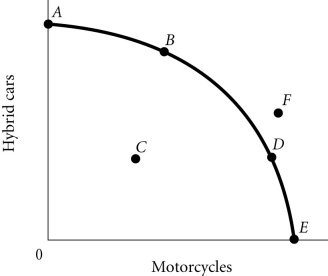Refer to the information provided in Figure 2.4 below to answer the question(s) that follow. Figure 2.4According to Figure 2.4, as the economy moves from Point D to Point B, the opportunity cost of hybrid cars, measured in terms of motorcycles,
Figure 2.4According to Figure 2.4, as the economy moves from Point D to Point B, the opportunity cost of hybrid cars, measured in terms of motorcycles,
A. initially increases, then decreases.
B. increases.
C. remains constant.
D. decreases.
Answer: B
You might also like to view...
Missouri can produce 10,000 tons of pecans per year or 5,000 tons of pears per year. Washington can produce 12,000 tons of pecans per year or 48,000 tons of pears per year. Which of the following statements about opportunity cost is CORRECT?
A) The opportunity cost of a ton of pecans is 2 tons of pears per ton of pecans for Missouri and 1/4 ton of pears per ton of pecans for Washington. B) The opportunity cost of a ton of pears is 2 tons of pecans per ton of pears for Missouri and 1/4 ton of pecans per ton of pears for Washington. C) The opportunity cost of a ton of pecans is 1/2 ton of pears per ton of pecans for Missouri and 4 tons of pears per ton of pecans for Washington. D) Both answers B and C are correct.
In recent years, the world demand curve for copper shifted rightward due to continued economic growth in China and other emerging economies. Also, the costs of extracting the copper increased due to higher energy prices. As a result, we observed:
A) higher equilibrium copper prices and unambiguously lower quantities. B) higher equilibrium copper prices and unambiguously higher quantities. C) higher equilibrium copper prices and either higher or lower quantities. D) lower equilibrium copper prices and either higher or lower quantities.
How can we anticipate the proportion of a newly imposed unit excise tax that consumers will pay?
A) Consumers will pay most of the tax whenever their demand for a product is relatively unresponsive to price changes. B) Consumers will always pay 100 percent of an excise tax. C) Consumers will pay most of the tax whenever their demand for the product is very price sensitive. D) Since producers always pay 100 percent of an excise tax, we know consumers will not pay any of the tax.
The hyperinflation of the Revolutionary War period was in part caused by the issuance of paper money with a face value in ______ of dollars
a. millions b. tens of millions c. hundreds of millions d. billions of dollars